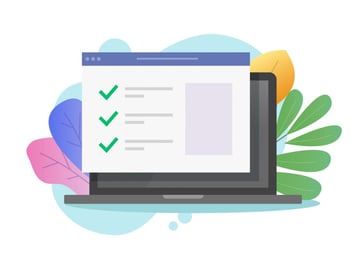
Author: Talya Bauer Ph.D
Download the employee onboarding checklist created by Talya Bauer. It is based on the 6Cs of onboarding to help you plan and execute your new hire's first few days and weeks on the job.
Introduction
Onboarding new employees is one of the most important things a company can do.
It’s also one of the most difficult. There are many things to think about, and it’s hard to know where to start.
That’s why it’s helpful to have a framework backed by behavioral research to follow.
In this post I’ll show you how the 6 C’s of employee onboarding will help you do everything you can to set your new hires up for success.
And help them get the best out of themselves.
The Benefits Of The 6 C’s of Employee Onboarding
Over the last three decades I have been studying the employee onboarding process, a lot has changed.
New employee onboarding began as what we now think of as orientation programs.
A Little History
In earlier days, onboarding processes included new hire paperwork, sharing the employee handbook, and orienting new hires in their jobs.
Yet these orientations were rarely considered a source of competitive advantage.
This all changed when the onboarding process became more than just orienting new hires.
Companies started realizing it is advantageous to have an entire process to help new employees learn the organization’s culture and build relationships with their coworkers.
Today, HR processes like onboarding have become a white hot talent management topic.
The Benefits
My own research, and that of many other academics, has consistently shown that effective onboarding leads to a variety of benefits:
- Faster adjustment
- Better job attitudes
- More customer referrals
- Better performance
- Higher employee engagement
- And stronger retention.
But that’s only the case if you have an effective onboarding process.
You have to do it right.
HR Professionals Everywhere Use The 6 C’s For Their Employee Onboarding Process
Organizations everywhere are focusing more and more on new employee onboarding.
And they are getting creative.
But if you’ve joined an organization and this is something that you are just starting to think about…
Or, if you feel like your onboarding process could use some improvement, you’re in the right place.
The nice thing is today’s talent market is causing almost every company to rethink their hiring process and onboarding.
So there’s no better time than right now to pick up new best practices and share your own.
That’s great news for those interested in helping employees and organizations create vibrant and effective workplaces.
This framework will instruct you on how to get the best out of your employees and help each individual get the best out of themselves in their jobs.
The best onboarding solutions have a memorable onboarding experience at their core.
How my interest in employee onboarding started
I have studied new employee onboarding for 25 years.
In fact, my Ph.D. dissertation at Purdue University included a study of new college graduates entering a variety of jobs.
I surveyed college graduates across campus before they graduated.
And several times after they’d started their new jobs.
You can learn more about my 5 keys to success in this article here where I dive a bit deeper into the onboarding process.
My work looked at a set of predictions specific to different stages and behaviors, and the relationship of these to important outcomes such as new employee performance, job satisfaction, and retention.
This included what happened during the recruitment process, what the manager did while new employees were onboarded, and what the new employees did themselves.
After spending 12 months following new hires into their new jobs and studying their onboarding successes and failures, many of my predictions turned out to be true.
In fact over the past two and half decades, I have been amazed at how powerful the onboarding process is.
And the direct impact a strong onboarding program has on outcomes like employee engagement.
Why Relationships Matter In Your Employee Onboarding Process
Relationships matter primarily because they connect us as human beings.
Few would actively disagree with such a statement.
But successful relationships require intention and effort.
Relationships And Onboarding Process
Interestingly, many organizations assume that a new employee’s need to belong and connect with colleagues will simply “work itself out” with time when it comes to onboarding.
It might – but then again, it might not.
Therefore, I help organizations develop proactive and strategic onboarding approaches that cultivate new hires’ sense of connection and belonging.
Direct Managers And The Sink-Or-Swim Philosophy
Hiring managers hold a unique key to the connection process.
In research I conducted with a colleague, we found that inability to establish meaningful connections with co-workers led new engineers to seek less information.24F[i]
However, if the new engineer and their manager were able to connect, the newcomer could overcome this hurdle even in the face of conflict with co-workers.
In other words, the relationship the new employee has with their manager was crucial to establishing a sense of belonging in the organization.
This relationship enabled them to freely seek information from the supervisor. Hence, these employees were positioned to succeed in the organization.
It’s a risky strategy to rely on new hies to “sink or swim” when connecting with their co-workers and hiring managers.
Organizations can help new hires maximize success by engaging in proven onboarding tasks, which I have developed and presented in this publication.
These are based on research, consulting, and observations regarding new employee success that consistently show that when you invest in new hires, they invest back into their co-workers, customers, and the organization.
[i] Sushil Nifadkar & Talya Bauer, 2016. “Breach of belongingness during socialization: Newcomer relationship conflict, information, and task-related outcomes. Journal of Applied Psychology, Volume 101, pages 1-13.
To get started with your own copy of the employee onboarding checklist, simply click here. We guarantee it'll be one of your best decisions this year.
The 6 C’s Of Employee Onboarding — Here They Are
- Compliance
- Clarification
- Confidence
- Connection
- Culture
- Checkback
It Started With 4 C’s, Then 5 C’s
I first developed the 4 C’s of onboarding a decade ago.
They were based on the academic research done on effective onboarding process and published by the SHRM Foundation (Society for Human Resource Management).
The 4 C’s since evolved into the 5 C’s of Onboarding: Compliance, Clarification, Confidence, Connection, and Culture.
The Sixth C Of Good Employee Onboarding
Further to this, and to add a layer of practicality, I added a 6th C, called Checkback.
Each of the 6 C’s is an essential component of the employee onboarding process.
And each progressive C indicates an increasing level of effectiveness as an organization’s onboarding process progresses on the scale from Compliance to Checkback.
Organizations that focus on the 6 C’s demonstrate more successful onboarding and business outcomes than those that do not.
COMPLIANCE – Housekeeping First

Compliance refers to the mandatory onboarding tasks needed for all new employees.
This is the classic onboarding checklist.
It includes completing legal paperwork, new hire badging, and provisioning tasks like equipping new employees with computers and phones as well as a workspace.
Organizations, even those that claim they do not have a formal onboarding program, must be compliant at this basic level to stay in business.
Therefore many employees spend their first day on the job filling out forms and miss the opportunity for connection.
You and I have both been there.
Organizations spend millions of hours and billions of dollars on the hiring process.
They work through the recruitment funnel to attract candidates, identify qualified candidates, assess candidates, and then finally hire them with the hope that they accept a job offer.
The irony is that they spend much less time thinking about improving the onboarding experience once they’ve actually joined.
CLARIFICATION Of Employee Roles And Expectations

Clarification refers to how well new hires understand their roles and performance expectations.
Of course, organizations hire new hires to do specific jobs, so clarifying what they need to be doing, how to do it, and how the organization functions in terms of rules and policies are important.
We also know that structure and clarity are essential for individual and team success.
Yet spending time learning these basics is not the most exciting way to spend your time when you’re new.
It’s essential to build ways to help new hires understand what is expected of them.
And make them feel equipped and supported in their decision to join your organization.
Further, to give them confidence in their ability to do a good job, which feeds into the next C.
Building New Employee CONFIDENCE

Confidence refers to employees’ feelings about doing the job well and their competence to tackle new challenges.
It is a state of mind.
While an organization cannot directly help new hires feel better about themselves, they can design onboarding experiences that help build up employees rather than tearing them down.
When employees feel more confident, they are more likely to feel good about those around them, as well as the choice to join your organization.
This is you going beyond the onboarding checklist.
Research conducted by Dan Cable25F[i] and his colleagues found that when onboarding programs focus on the new employee’s value and encourages them to share themselves at work, it can immediately increase performance and retention.
Helping Employees Build Meaningful CONNECTIONS

Connection refers to how accepted and valued new hires feel.
When new employees feel connected to their colleagues and recognized at work, they feel safe.
Research has consistently shown that a sense of connection leads to various positive individual and organizational outcomes.
When new hires feel connected and secure, they ask questions and try new things.
Additionally, they engage more fully with their co-workers, their role, and the organization with a greater sense of appreciation.
It is a factor that helps new employees feel that they made the right decision to join the organization.
Gallup has consistently found that having a close friend at work is related to a 50% boost in job satisfaction and that those employees with a best friend at work were seven times more likely to engage with their work fully.
26F[ii] This starts with onboarding. If new hires feel alone and isolated on their first day, it can be challenging to recover, as researchers found at Microsoft.
UPDATE: A recent meta study done of 256 onboarding studies also show the importance of Connection.
Shared CULTURE Is Constantly Evolving

Culture refers to how well new hires understand their new organization’s norms, values, stories, and symbols.
This is where companies, even if they invest heavily in onboarding, usually need help.
Cultural onboarding is one of the key ways company culture is formed, maintained, and changed.
When I was working at Google, we focused on onboarding as a KPI in People Operations because the number of new hires at Google was forecast to double within 18 months.
That turned out to be true.
We needed to identify the Google company culture and how this growth would impact it.
One important consideration was acknowledging the stories about how the company was founded yet respecting that its norms, missions, and goals were constantly evolving.
Most companies have this written somewhere.
Add it to your onboarding checklist.
This is a great way to teach your people what matters within your organization. Right at the beginning.
It is also a great way to learn about how your organization can evolve for the better and learn about the contributions of new hires to the organization’s future.
Onboarding CHECKBACKS Are Critical For Long-term Success

Checkback refers to onboarding feedback.
The data you receive from new hires about the employee experience is invaluable.
As you can see throughout this book, there are considerable benefits to executing onboarding purposefully and playfully.
Yet, even the best onboarding plans sometimes don’t turn out the way we hope.
This is why it is vital for all onboarding programs to include the sixth C of Checkback.
The only way to know if your onboarding programs are working is to ask new hires.
Hopefully you’re using onboarding tools, perhaps employee onboarding software, to help you.
Before a new hire begins, plan when you’ll check back with them and what you’ll be wanting to know from them. can
Use check-ins to adjust your onboarding program on the go as you learn more about what is and isn’t working.
You should also survey managers and other stakeholders to assess what is working well, what should be repeated for future newcomers, and what needs to be adjusted to ensure a world-class onboarding experience.
The Checkback insights will help you benchmark results and find problem areas.
These will support your business case to drive organizational change and iterate and improve areas that need attention.
[i] https://hbr.org/2015/11/the-powerful-way-onboarding-can-encourage-authenticity
[ii] C. Riordan, ‘We all need friends at work’, Harvard Business Review, July 3, 2013. Last accessed 12/21/21. https://hbr.org/2013/07/we-all-need-friends-at-work
Conclusion
The onboarding experience is one of the most important ways to set new hires up for success.
It is a process that helps new employees feel welcomed, connected, and secure.
Onboarding also provides feedback so that employers can assess how well their programs are working.
If you already have an employee onboarding process checklist, great! Use this framework to streamline HR processes and get better.
If you don’t have a structured onboarding process yet, don’t worry.
Use the 6 C’s to get started. Find your blindspots. Add steps you may have missed to your onboarding checklist.
The 6 C’s are: Compliance, Clarification, Confidence, Connection, Culture, and Checkback.
This framework will help you create an onboarding process that sets your new hires up for success and helps your organization retain top talent.
Thanks for reading!
Get the employee onboarding checklist now and make sure your next new hire has a great experience from day one.